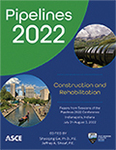Post-Fire Mechanical Properties of Thermally Sprayed Anti-Corrosive Coatings in Oil and Gas Pipelines
Publication: Pipelines 2022
ABSTRACT
In the past 10 years, about 1,200 fire accidents were reported in oil and gas pipelines with protective coatings. Metallic coatings are popular in oil and gas pipelines due to their excellent performance in corrosion prevention. This paper quantifies the changes in mechanical properties such as hardness and wear-resistance of thermally sprayed anti-corrosive coatings in steel oil and gas pipelines exposed to fire accidents. Specifically, two types of wire arc sprayed metallic coatings, including the Zn-15Al and Zn-Al pseudo alloy coatings, are investigated. These coatings are exposed to high temperatures ranging from 300°C to 700°C for an hour simulating fire accidents and are cooled down by air cooling, which is common after an accident in the field. Results indicated that the Zn-Al pseudo alloy failed at 600°C and the Zn-15Al survived until 700°C. The results of this study will help to evaluate the integrity and residual life of metallic coatings used in steel pipelines after being exposed to fire accidents.
Get full access to this article
View all available purchase options and get full access to this chapter.
REFERENCES
Demirtas, M., G. Purcek, H. Yanar, Z. Zhang, and Z. Zhang. (2015). “Effect of chemical composition and grain size on RT superplasticity of Zn-Al alloys processed by ECAP.” Letters on materials 5(3): 328–334.
Deng, F., Y. Huang, F. Azarmi, and Y. Wang. (2017). “Pitted corrosion detection of thermal sprayed metallic coatings using fiber Bragg grating sensors.” Coatings 7(3): 35.
Fessler, R. R. (2008). “Pipeline corrosion.”, US Department of Transportation Pipeline and Hazardous Materials Safety Administration, Baker, Evanston, IL.
Geels, K., D. B. Fowler, W.-U. Kopp, and M. R. Ckert. (2007). Metallographic and materialographic specimen preparation, light microscopy, image analysis, and hardness testing, ASTM international West Conshohocken.
Green, K. P., and T. Jackson. (2015). Safety in the transportation of oil and gas: Pipelines or rail?, Fraser Institute Vancouver, BC.
Kennedy, J. L. (1984). Oil and gas pipeline fundamentals.
Klass, A. B., and D. Meinhardt. (2014). “Transporting oil and gas: US infrastructure challenges.” Iowa L. Rev. 100: 947.
Kobayashi, A. (1996). “Characteristics of high hardness alumina coatings formed by gas tunnel plasma spraying.” Journal of Thermal Spray Technology 5(3): 298–302.
Lam, C., and W. Zhou. (2016). “Statistical analyses of incidents on onshore gas transmission pipelines based on PHMSA database.” International Journal of Pressure Vessels and Piping 145: 29–40.
Li, M., Y. Li, F. Xue, and X. Jing. (2019). “A robust and versatile superhydrophobic coating: Wear-resistance study upon sandpaper abrasion.” Applied Surface Science 480: 738–748.
Liu, S., Y. Zhu, X. Lai, X. Zheng, R. Jia, and X. Yuan. (2019). “Influence of different heat treatment temperatures on the microstructure, corrosion, and mechanical properties behavior of Fe-based amorphous/nanocrystalline coatings.” Coatings 9(12): 858.
ASTM. (2017). ASTM E-92: standard test methods for vickers hardness and knoop hardness of metallic materials, ASTM West Conshohocken.
Sajid, H. U., and R. Kiran. (2019). “Post-fire mechanical behavior of ASTM A572 steels subjected to high stress triaxialities.” Engineering Structures 191: 323–342.
Sajid, H. U., D. L. Naik, and R. Kiran. (2020). “Microstructure–Mechanical Property Relationships for Post-Fire Structural Steels.” Journal of Materials in Civil Engineering 32(6): 04020133.
Sharma, S. K., and S. Maheshwari. (2017). “A review on welding of high strength oil and gas pipeline steels.” Journal of Natural Gas Science and Engineering 38: 203–217.
Yung, T.-Y., T.-C. Chen, K.-C. Tsai, W.-F. Lu, J.-Y. Huang, and T.-Y. Liu. (2019). “Thermal spray coatings of Al, ZnAl and inconel 625 alloys on SS304L for anti-saline corrosion.” Coatings 9(1): 32.
Zhi, J.-H., L.-Z. Zhang, Y. Yan, and J. Zhu. (2017). “Mechanical durability of superhydrophobic surfaces: The role of surface modification technologies.” Applied Surface Science 392: 286–296.
Information & Authors
Information
Published In
History
Published online: Jul 28, 2022
Authors
Metrics & Citations
Metrics
Citations
Download citation
If you have the appropriate software installed, you can download article citation data to the citation manager of your choice. Simply select your manager software from the list below and click Download.
